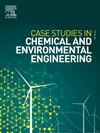Rapid SO2 gas removal using MgO/AC /CaCO3/Zeolite nanocomposite at room temperature
Q1 Environmental Science
Case Studies in Chemical and Environmental Engineering
Pub Date : 2024-12-04
DOI:10.1016/j.cscee.2024.101042
引用次数: 0
Abstract
The rising population and the expansion of urban areas are leading to heightened energy demands, which are predominantly met through fossil fuel sources. The operation of combustion facilities generates detrimental flue gases, thereby necessitating investigations into methods for controlling emissions to safeguard public health and protect the environment. The adsorbent method of removing pollutant gases involves selecting the proper material, preparation of the adsorbent layer, understanding adsorption mechanisms, contact time, and monitoring levels of pollutants. Various types of adsorbent materials are utilized, including active carbon (AC), zeolites, and metal oxides; each has different properties that affect the efficiency of pollutant removal. This research examined the MgO/AC/CaCO3/Zeolite nanocomposite for SO2 gas removal. The characterization of the adsorbent layer was conducted using X-ray diffraction (XRD), scanning electron microscopy (SEM), and Brunauer-Emmett-Teller (BET) analysis techniques. The findings demonstrated a swift decline in SO2 level, which decreased from 153 ppm to 15 ppm in a short time of 5 minutes. The MgO/AC/CaCO3/Zeolite film can considerably remove the SO2 gas with an efficiency of 92 % at room temperature. The adsorbent film exhibited an adsorption capacity of 133 mg g−1 within 5 minutes. The results of this study provide important insights into the removal of SO2 gas by using adsorption layers, demonstrating the potential of MgO/AC/CaCO3/zeolite nanocomposites as effective materials for air pollution control. This nanocomposite can effectively reduce SO2 with fast adsorption time. As air quality standards continue to be tightened around the world, innovative materials can play a significant role in reducing harmful emissions from industrial sources.
MgO/AC /CaCO3/沸石纳米复合材料在室温下快速脱除SO2气体
人口的增加和城市地区的扩大导致能源需求的增加,而这些需求主要是通过化石燃料来满足的。燃烧设施的运行产生有害的烟道气体,因此有必要研究控制排放的方法,以保障公众健康和保护环境。吸附法去除污染气体包括选择合适的材料、制备吸附剂层、了解吸附机理、接触时间和监测污染物水平。使用了各种类型的吸附材料,包括活性炭(AC),沸石和金属氧化物;每一种都有不同的特性,影响污染物去除的效率。研究了MgO/AC/CaCO3/沸石纳米复合材料对SO2气体的去除效果。利用x射线衍射(XRD)、扫描电镜(SEM)和布鲁诺尔-埃米特-泰勒(BET)分析技术对吸附层进行了表征。结果表明,SO2水平迅速下降,在短短5分钟的时间内从153 ppm下降到15 ppm。MgO/AC/CaCO3/沸石膜在室温下对SO2气体的去除率达到92%。吸附膜在5分钟内的吸附量为133 mg g−1。本研究结果为利用吸附层去除SO2气体提供了重要的见解,证明了MgO/AC/CaCO3/沸石纳米复合材料作为有效的空气污染控制材料的潜力。该纳米复合材料能有效降低SO2,吸附时间短。随着世界各地的空气质量标准不断收紧,创新材料可以在减少工业污染源的有害排放方面发挥重要作用。
本文章由计算机程序翻译,如有差异,请以英文原文为准。
求助全文
约1分钟内获得全文
求助全文
来源期刊

Case Studies in Chemical and Environmental Engineering
Engineering-Engineering (miscellaneous)
CiteScore
9.20
自引率
0.00%
发文量
103
审稿时长
40 days
 求助内容:
求助内容: 应助结果提醒方式:
应助结果提醒方式:


